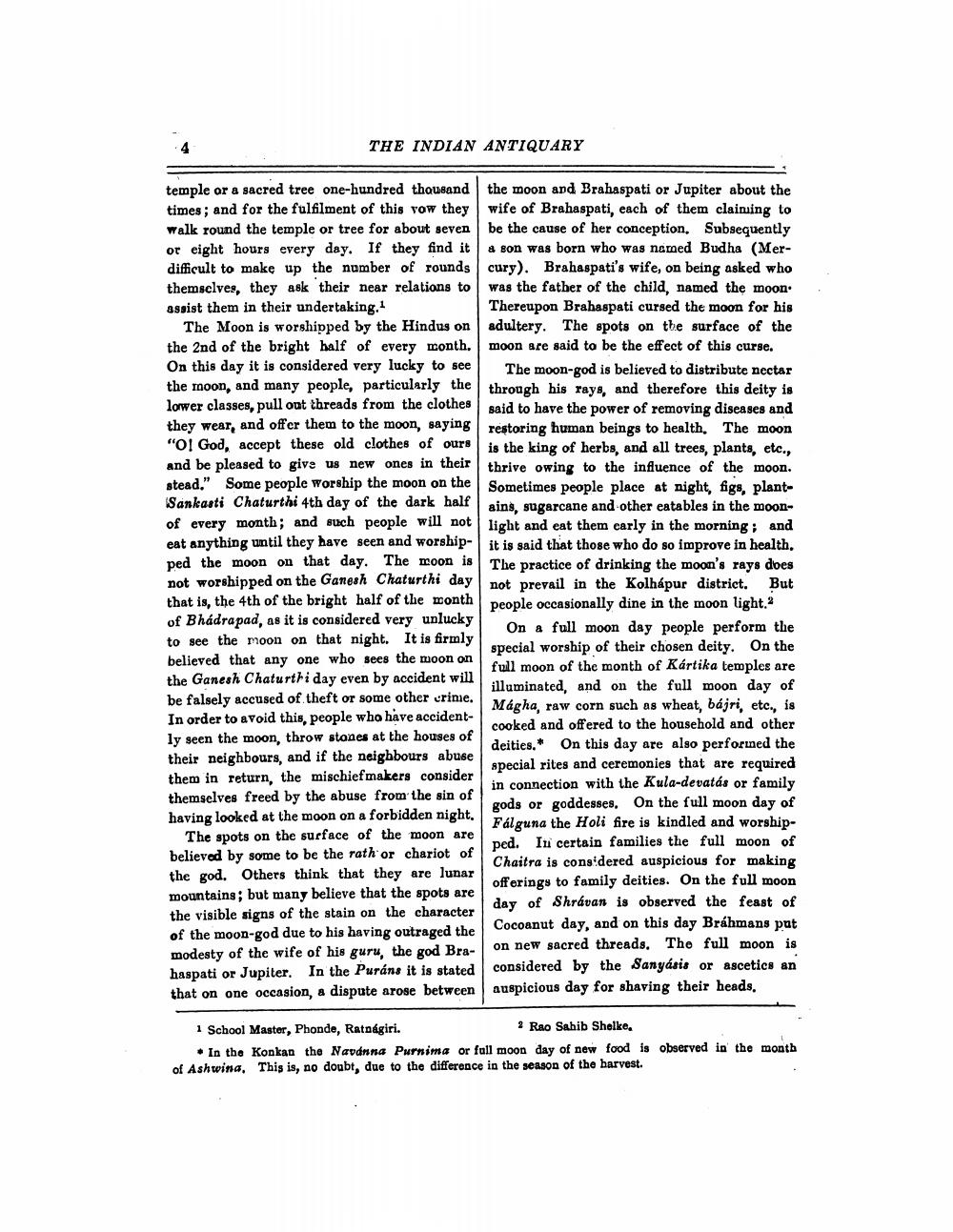________________
THE INDIAN ANTIQUARY
temple or a sacred tree one-hundred thousand times; and for the fulfilment of this vow they walk round the temple or tree for about seven or eight hours every day. If they find it difficult to make up the number of rounds themselves, they ask their near relations to assist them in their undertaking.1
The Moon is worshipped by the Hindus on the 2nd of the bright half of every month. On this day it is considered very lucky to see the moon, and many people, particularly the lower classes, pull out threads from the clothes they wear, and offer them to the moon, saying "O! God, accept these old clothes of ours and be pleased to give us new ones in their stead." Some people worship the moon on the Sankasti Chaturthi 4th day of the dark half of every month; and such people will not eat anything until they have seen and worshipped the moon on that day. The moon is not worshipped on the Ganesh Chaturthi day that is, the 4th of the bright half of the month of Bhadrapad, as it is considered very unlucky to see the moon on that night. It is firmly believed that any one who sees the moon on the Ganesh Chaturthi day even by accident will be falsely accused of theft or some other crinie. In order to avoid this, people who have accident
ly seen the moon, throw stones at the houses of their neighbours, and if the neighbours abuse them in return, the mischief makers consider themselves freed by the abuse from the sin of having looked at the moon on a forbidden night. The spots on the surface of the moon are believed by some to be the rath or chariot of the god. Others think that they are lunar mountains; but many believe that the spots are the visible signs of the stain on the character of the moon-god due to his having outraged the modesty of the wife of his guru, the god Brahaspati or Jupiter. In the Puráns it is stated that on one occasion, a dispute arose between
the moon and Brahaspati or Jupiter about the wife of Brahaspati, each of them claiming to be the cause of her conception. Subsequently a son was born who was named Budha (Mercury). Brahaspati's wife, on being asked who was the father of the child, named the moon. Thereupon Brahaspati cursed the moon for his adultery. The spots on the surface of the moon are said to be the effect of this curse.
The moon-god is believed to distribute nectar through his rays, and therefore this deity is said to have the power of removing diseases and restoring human beings to health. The moon is the king of herbs, and all trees, plants, etc., thrive owing to the influence of the moon. Sometimes people place at night, figs, plantains, sugarcane and other eatables in the moonlight and eat them early in the morning; and it is said that those who do so improve in health. The practice of drinking the moon's rays does not prevail in the Kolhapur district. But people occasionally dine in the moon light.2
On a full moon day people perform the special worship of their chosen deity. On the
full moon of the month of Kártika temples are
illuminated, and on the full moon day of Mágha, raw corn such as wheat, bájri, etc., is
cooked and offered to the household and other
deities.
On this day are also performed the special rites and ceremonies that are required in connection with the Kula-devatás or family gods or goddesses. On the full moon day of Fálguna the Holi fire is kindled and worshipped. In certain families the full moon of Chaitra is considered auspicious for making
offerings to family deities. On the full moon day of Shrávan is observed the feast of Cocoanut day, and on this day Brahmans put on new sacred threads. The full moon is considered by the Sanyásis or ascetics an auspicious day for shaving their heads,
1 School Master, Phonde, Ratnagiri.
2 Rao Sahib Shelke.
In the Konkan the Navánna Purnima or full moon day of new food is observed in the month
of Ashwina, This is, no doubt, due to the difference in the season of the harvest.




